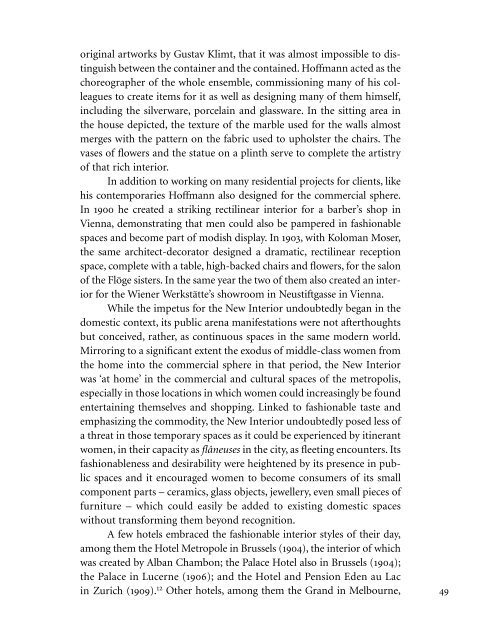Create successful ePaper yourself
Turn your PDF publications into a flip-book with our unique Google optimized e-Paper software.
original artworks by Gustav Klimt, that it was almost impossible to distinguish<br />
between the container and the contained. Hoffmann acted as the<br />
choreographer of the whole ensemble, commissioning many of his colleagues<br />
to create items for it as well as designing many of them himself,<br />
including the silverware, porcelain and glassware. In the sitting area in<br />
the house depicted, the texture of the marble used for the walls almost<br />
merges with the pattern on the fabric used to upholster the chairs. <strong>The</strong><br />
vases of flowers and the statue on a plinth serve to complete the artistry<br />
of that rich interior.<br />
In addition to working on many residential projects for clients, like<br />
his contemporaries Hoffmann also designed for the commercial sphere.<br />
In 1900 he created a striking rectilinear interior for a barber’s shop in<br />
Vienna, demonstrating that men could also be pampered in fashionable<br />
spaces and become part of modish display. In 1903, with Koloman Moser,<br />
the same architect-decorator designed a dramatic, rectilinear reception<br />
space, complete with a table, high-backed chairs and flowers, for the salon<br />
of the Flöge sisters. In the same year the two of them also created an inter -<br />
ior for the Wiener Werkstätte’s showroom in Neustiftgasse in Vienna.<br />
While the impetus for the New <strong>Interior</strong> undoubtedly began in the<br />
domestic context, its public arena manifestations were not afterthoughts<br />
but conceived, rather, as continuous spaces in the same modern world.<br />
Mirroring to a significant extent the exodus of middle-class women from<br />
the home into the commercial sphere in that period, the New <strong>Interior</strong><br />
was ‘at home’ in the commercial and cultural spaces of the metropolis,<br />
especially in those locations in which women could increasingly be found<br />
entertaining themselves and shopping. Linked to fashionable taste and<br />
emphasizing the commodity, the New <strong>Interior</strong> undoubtedly posed less of<br />
a threat in those temporary spaces as it could be experienced by itinerant<br />
women, in their capacity as flâneuses in the city, as fleeting encounters. Its<br />
fashionableness and desirability were heightened by its presence in public<br />
spaces and it encouraged women to become consumers of its small<br />
component parts – ceramics, glass objects, jewellery, even small pieces of<br />
furniture – which could easily be added to existing domestic spaces<br />
without transforming them beyond recognition.<br />
A few hotels embraced the fashionable interior styles of their day,<br />
among them the Hotel Metropole in Brussels (1904), the interior of which<br />
was created by Alban Chambon; the Palace Hotel also in Brussels (1904);<br />
the Palace in Lucerne (1906); and the Hotel and Pension Eden au Lac<br />
in Zurich (1909). 12 Other hotels, among them the Grand in Melbourne, 49



